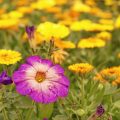1. Introduction to Perennials
Perennial flowers are the heart and soul of many American gardens. Unlike annuals, which complete their life cycle in a single season, perennials come back year after year—bringing color, structure, and joy to your yard with less effort over time. Their dependable nature makes them a favorite among gardeners across the United States, from Florida’s warm climate to the cooler regions of the Pacific Northwest.
The key feature that sets perennials apart is their unique growth cycle. These plants go dormant during colder months and re-emerge when the weather warms up. This means you plant them once, and they reward you with blooms for several seasons—saving both time and money in the long run.
Here’s a quick comparison between perennials and other types of garden plants:
| Plant Type | Lifespan | Bloom Time | Maintenance |
|---|---|---|---|
| Perennials | 3+ years | Seasonal (returns yearly) | Low to moderate |
| Annuals | 1 growing season | All season (until frost) | Moderate to high |
| Biennials | 2 years | Second year only | Moderate |
American gardeners love perennials not only for their resilience but also for their wide variety of colors, shapes, and sizes. Whether youre looking to fill a sunny border, shade garden, or attract pollinators like butterflies and bees, theres a perennial out there that fits your needs. In this series, we’ll explore the top 25 perennial flowers that thrive across different USDA zones and bring lasting beauty to any landscape.
2. Climate Zones and Regional Suitability
When choosing perennial flowers for your garden, one of the most important factors to consider is your USDA hardiness zone. The United States spans a wide range of climates—from the frosty winters of the Northeast to the dry heat of the Southwest—so picking plants that thrive in your specific region is key to long-lasting blooms and low-maintenance care.
Understanding USDA Hardiness Zones
The USDA Plant Hardiness Zone Map divides North America into 13 zones based on average annual minimum winter temperatures. Each zone represents a 10°F difference in temperature. Knowing your zone helps you pick perennials that can survive year-round in your area.
General Overview of USDA Zones
| Zone | Temperature Range (°F) | Typical Regions |
|---|---|---|
| 3-4 | -40 to -20 | Northern Midwest, Northern New England |
| 5-6 | -20 to 0 | Northeast, Upper Midwest |
| 7-8 | 0 to 20 | Southeast, Mid-Atlantic, Pacific Northwest |
| 9-10 | 20 to 40 | Southern California, South Texas, Florida |
| 11-13 | Above 40 | Hawaii, Southern tip of Florida, parts of Puerto Rico |
Selecting Perennials by Region
Northeast (Zones 3–6)
This region experiences cold winters and mild summers. Choose hardy perennials like:
- Daylilies (Hemerocallis): Extremely resilient and bloom from early summer into fall.
- Peonies: Thrive in cold climates and return year after year with stunning blooms.
- Black-eyed Susan (Rudbeckia): Loves sun and tolerates humidity well.
- Coral Bells (Heuchera): Offers colorful foliage and handles southern heat.
- Coneflowers (Echinacea): Drought-tolerant and attractive to pollinators.
- Baptisia: Very hardy with striking blue or purple flowers.
- Lavender: Thrives in dry conditions and brings fragrance to any garden.
- Purple Sage (Salvia dorrii): Well-suited for xeriscaping and poor soils.
- Astilbe: Prefers shade and moist soil; perfect for woodland gardens.
- Lungwort (Pulmonaria): Tolerates wet conditions and adds spring color.
- Busy homeowners who want beauty with minimal effort
- Beginner gardeners learning the ropes
- Eco-conscious gardeners looking to conserve water and reduce chemical use
- Cottage Garden Feel: Mix pinks, blues, and whites with Peonies, Salvia, and Foxglove.
- Sizzling Summer Vibe: Combine oranges and reds with Daylilies, Blanket Flower, and Bee Balm.
- Cool & Calm: Use purples and silvers with Russian Sage, Lavender, and Catmint.
- Diversify foliage: Not all beauty comes from flowers. Add plants like Hostas or Coral Bells for colorful leaves.
- Add evergreens: Small evergreen shrubs give structure year-round.
- Use mulch: Helps retain moisture and keeps weeds down around your perennials.
Southeast (Zones 7–9)
This area is warm and humid with long growing seasons. Ideal perennials include:
Midwest (Zones 4–6)
The Midwest has hot summers and cold winters. Great choices are:
Southwest (Zones 7–10)
This region includes arid deserts and dry heat. Consider drought-resistant perennials such as:
Pacific Northwest (Zones 7–9)
Mild temperatures and high rainfall make this region ideal for moisture-loving plants:
Your Next Step: Know Your Zone!
If youre unsure about your USDA zone, you can look it up easily online using your zip code. Once you know it, youll be better equipped to choose from our Top 25 Perennial Flowers that will flourish right where you live.
Selecting climate-appropriate perennials not only ensures beautiful blooms but also reduces maintenance, water use, and plant loss—making gardening more enjoyable no matter where you are in America!
![]()
3. Top Perennial Picks for Sun and Shade
Explore a curated selection of perennials that thrive in sunny spots and shaded areas, perfect for balancing your garden’s layout. Whether your yard is bathed in sunshine or tucked beneath leafy trees, theres a perennial flower that can bring color and life to every corner.
Best Perennials for Sunny Areas
If you have a garden space that receives full sun (6+ hours of direct sunlight daily), these perennials are great choices. They love the heat and often reward gardeners with vibrant blooms all summer long.
| Flower | Color Range | Bloom Season | USDA Zones |
|---|---|---|---|
| Black-eyed Susan (Rudbeckia hirta) | Yellow with dark centers | Summer to early fall | 3–9 |
| Coreopsis (Coreopsis spp.) | Yellow, pink, red | Late spring to fall | 4–9 |
| Salvia (Salvia nemorosa) | Purple, blue, pink | Late spring through summer | 4–9 |
| Shasta Daisy (Leucanthemum × superbum) | White with yellow centers | Summer | 5–9 |
| Russian Sage (Perovskia atriplicifolia) | Lavender-blue | Midsummer to fall | 4–9 |
Top Perennials for Shaded Spots
Shady gardens can be just as colorful and lively as sunny ones. These shade-loving perennials are ideal for areas under trees or along north-facing walls where sunlight is limited.
| Flower | Color Range | Bloom Season | USDA Zones |
|---|---|---|---|
| Hosta (Hosta spp.) | Green foliage; white or lavender flowers | Summer (flowers); foliage spring to fall | 3–9 |
| Astilbe (Astilbe spp.) | Pinks, whites, reds, purples | Late spring to midsummer | 4–8 |
| Bleeding Heart (Dicentra spectabilis) | Pink, white hearts on arching stems | Spring to early summer | 3–9 |
| Lungwort (Pulmonaria spp.) | Purple, pink, blue (often changes color) | Early spring to late spring | 3–8 |
| Siberian Bugloss (Brunnera macrophylla) | Tiny blue flowers; heart-shaped leaves | Spring to early summer | 3–8 |
A Balanced Garden Starts With the Right Plants
Selecting perennials based on sun exposure ensures healthy growth and vibrant blooms. Mix both sun- and shade-tolerant varieties throughout your landscape to create visual interest and year-round appeal. Whether you’re working with a sunny backyard or a shady front porch border, there’s a perennial that fits perfectly into your American garden.
4. Low-Maintenance Favorites
If youre new to gardening or just don’t have time for high-maintenance plants, low-care perennials are a perfect choice. These flowers bring color and charm to your garden without requiring constant pruning, watering, or pest control. Let’s take a look at some easy-going favorites that thrive across many U.S. regions.
Why Choose Low-Maintenance Perennials?
Low-maintenance perennials are ideal for:
Top Easy-Care Perennial Flowers
| Flower | USDA Zones | Sun Requirements | Highlights |
|---|---|---|---|
| Black-eyed Susan (Rudbeckia) | 3–9 | Full Sun | Drought-tolerant, long bloom season |
| Daylily (Hemerocallis) | 3–10 | Full Sun to Partial Shade | Tough and adaptable, blooms in waves |
| Coneflower (Echinacea) | 3–9 | Full Sun | Pollinator-friendly, low water needs |
| Lamb’s Ear (Stachys byzantina) | 4–9 | Full Sun to Partial Shade | Soft silvery leaves, great groundcover |
| Sedum (Stonecrop) | 3–9 | Full Sun | Drought-resistant, excellent for borders |
Caring for These Low-Maintenance Beauties
While these flowers don’t need much attention, here are a few simple tips to keep them thriving:
#1 Water Wisely
Most of these perennials prefer well-drained soil and can tolerate short periods of drought. Deep watering once a week is usually enough.
#2 Minimal Fertilizer Needed
A yearly application of compost or slow-release fertilizer in early spring will support healthy growth without overfeeding.
#3 Occasional Deadheading Helps
Removing spent blooms from plants like coneflowers and black-eyed Susans can encourage longer blooming seasons.
Tip:
If you’re planting in containers, choose drought-tolerant varieties like sedum for less frequent watering.
Selecting these dependable perennials means more time enjoying your garden and less time working in it. Whether you have a sunny backyard or a small patio space, these flowers offer fuss-free color year after year.
5. Design Tips for a Blooming Landscape
Creating a vibrant garden that blooms from early spring through late fall doesn’t have to be complicated. With smart planting combinations, thoughtful color themes, and attention to bloom succession, your perennial garden can look stunning across the seasons. Here are some friendly and easy-to-follow tips to help you design a colorful and lively American garden using our top 25 perennials.
Planting Combinations That Work
Mixing perennials based on their height, texture, and blooming times creates visual interest and helps fill your garden space efficiently. Try pairing tall spiky flowers like Delphinium with bushy plants like Black-Eyed Susan. Low-growing ground covers like Creeping Phlox work great at the front of borders or along walkways.
| Height Layer | Suggested Perennials |
|---|---|
| Tall (Back) | Delphinium, Joe Pye Weed, Hollyhock |
| Medium (Middle) | Shasta Daisy, Coneflower, Coreopsis |
| Low (Front) | Creeping Phlox, Heuchera, Lamb’s Ear |
Create Eye-Catching Color Themes
Selecting a color palette for your garden helps it feel cohesive and intentional. You can go bold with contrasting colors like purple and yellow or keep it calm with soft pastels such as lavender and pink. Here are a few ideas to get you started:
Plan for Continuous Blooming
The secret to a garden that stays colorful all season is choosing perennials with staggered bloom times. Planting early-, mid-, and late-season bloomers ensures there’s always something flowering in your yard.
| Season | Blooming Perennials |
|---|---|
| Spring (March–May) | Iris, Creeping Phlox, Columbine |
| Summer (June–August) | Coneflower, Shasta Daisy, Daylily |
| Fall (September–October) | Aster, Sedum, Goldenrod |
A Few Extra Tips:
A well-planned perennial garden can offer nonstop color while being low-maintenance in the long run. By combining heights, colors, and bloom times from our top 25 picks, youll create a landscape thats uniquely yours—and one that shines throughout the American growing season.


